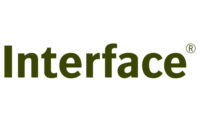Interface Achieves Carbon Negative Milestone with the Launch of Innovative Products

Interface, a worldwide commercial flooring company, introduced the world’s first carbon negative carpet tile.* To achieve this milestone, Interface has transformed key manufacturing facilities and incorporated new materials to create its new CQuest™ backings line, which includes a new carpet backing that stores more carbon than any before.
One of these new backings – CQuest™BioX – combined with specialty yarns and proprietary tufting processes, results in a carbon negative carpet tile when measured cradle to gate. This means that after it is made, there is less carbon dioxide in the atmosphere than if the tile had not been manufactured in the first place.
Interface began its journey to develop carbon negative products following the adoption of Climate Take Back™, which aims to reverse global warming. This led Interface to consider how it could continue to reduce the carbon footprints of its products as it endeavors to become a carbon negative enterprise by 2040. Building on the 2018 launch of its third-party verified Carbon Neutral Floors™ program, the company’s innovative new products enable Interface to make simultaneous progress toward its goals of becoming a carbon negative company and of helping customers deliver on their own sustainability objectives. By using carbon negative carpet tiles from Interface, designers and specifiers can lower the carbon footprints of the spaces they create without sacrificing function, performance, or style.
Through the carbon cycle, nature manages and processes carbon in a way that provides balance to the planet. However, because human activity puts this carbon cycle out of balance, it is essential that society not only reduce carbon emissions but find creative ways to remove carbon from the atmosphere, where it contributes to global warming. Taking a cue from nature, Interface learned to work with carbon by using it as a building block to engineer better products. The company’s innovative carbon negative carpet tiles store carbon, keeping it out of the atmosphere.
“Interface is committed to changing the landscape of the flooring industry and to reversing global warming by spearheading continually more sustainable manufacturing practices,” said John Bradford, chief science and technology officer at Interface. “Companies today need to do more than simply avoid carbon emissions; they need to find ways to mimic nature’s carbon cycle by storing and using carbon as a resource. We are challenging ourselves and the industry at large to work in greater harmony with the planet.”
To develop its first carbon negative carpet tile, Interface began by evolving its manufacturing to deliver the next generation of its trusted backings platform with the introduction of its new CQuest backings.
Guided by materials science and inspired by nature’s carbon-storing abilities, the company added new bio-based materials and more recycled content to its backings. Then, Interface measured how these materials influence the carbon footprint. These new materials, measured on a stand-alone basis, are net carbon negative – resulting in carbon negative backings.
The new CQuest backings line includes:
- CQuest™GB - The next evolution of the company’s GlasBac™ backing. It features the same superior performance with a construction of post-consumer recycled content from carpet tiles, bio-based additives, and pre-consumer recycled materials, which are net carbon negative.**
- CQuest™Bio - A non-vinyl bio-composite backing made with bio-based and recycled fillers, which are net carbon negative.**
- CQuest™BioX - The Interface backing that stores the most carbon. It is the same material make-up as CQuestBio with a higher concentration of carbon negative materials.
“This breakthrough has been years in the making. Our dedicated global Interface team, from R&D to manufacturing to product design and marketing, has worked hard to 'walk the walk,' as our founder Ray Anderson would say," said Dan Hendrix, Interface chairman and CEO. "Products that minimize carbon in the built environment are a priority for Interface and a huge focus for the building industry. Our carbon negative carpet tiles are designed for our A&D customers who want to specify high-design, low-carbon products and for our end-user customers who consider carbon in their procurement decisions to meet their own sustainability goals. By bringing new carbon negative products to market, we will continue to create a ripple effect, inspiring others across industries to address global warming and join us on our path to a carbon negative future.”
Interface is introducing its first three carbon negative carpet tile styles as part of the company’s new Embodied Beauty™ collection, currently available in the Americas and expected to launch globally in 2021. In addition, the new CQuest backings are available with other carpet tile products manufactured in the Americas. Select Interface carpet styles manufactured in Europe are currently available on CQuestBio backing.
To learn more about carbon negative products from Interface and about the company’s efforts to reduce its own carbon footprint and that of the built environment, visit http://www.interface.com/carbonnegative. For more information about the Embodied Beauty collection, visit http://www.interface.com/embodiedbeauty.
*Based on publicly available information from The International EPD® System, Institut Bauen und Umwelt e.V., and UL Environment.
**Carpet tiles made with CQuestBio and CQuestGB backings are not carbon negative carpet tiles; however, they are carbon neutral across their full product life cycle through the company’s third-party verified Carbon Neutral Floors program.
Looking for a reprint of this article?
From high-res PDFs to custom plaques, order your copy today!








.jpg?t=1690771780)
